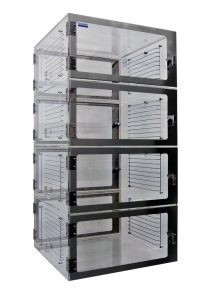Most laboratories demand a clean, germ-free, dry environment for conducting its researches or dealing with hazardous chemicals. These need special storage conditions to avoid any accidents. The workers and scientists come across super reactive and aggressive compounds that may be toxic. They cannot be left out in the open and require sensitive handling. Even the slightest environmental changes can trigger an explosive reaction that may be dangerous or even fatal to lab personnel.
What is a pass-through desiccator?
Several chemicals are highly reactive to moisture, known as hygroscopic chemicals that need sensitive handling. Pass through desiccators are an efficacious lab device that contains enclosed chambers to preserve reactive chemicals and implement its safe maneuver. They assure a moisture-free surrounding for humidity sensitive products and play a vital role in personnel security.
What is its elementary role?
There are various types of desiccators available in the market that use desiccants for bringing the humidity level down and suck in all the moisture to make air dry within its cabinets. The kind of desiccant used might vary though all have a common purpose. Of which, pass-through desiccators are more efficient as they provide multiple chamber handling at a single time. The substances can be transferred from one chamber to another without exposing it to pressure, humidity, and temperature changes by the external environment. That enhances security while handling and maintain the optimal microenvironment conditions.
Specifications of a pass-through desiccator
Have you been wondering about the best pass-through desiccator for your lab work? We, through this article, want to give a brief detail on general specification guidelines that must be kept in mind while making your choice.
The most important feature of these desiccators is that it should have separate air locked chambers for transferring compounds through channels safely. It should be completely sealed to avoid any unwanted contamination or changes in humidity levels. Dryness can be achieved by desiccants or with the help of a gas purge system to control air pressure and relative humidity level.
They should have dual-sided access doors – one for entry and the other for exit. When one of them opens then the other should be automatically locked to allow safe handling of the compound. There are gaskets on the door to make it airtight, so they should be checked periodically to ensure tightness. The door panels must be SDPVC coated to avoid electrostatic discharge. That is essential for the safety of lab personnel also. The device should be convenient to use for enhanced purposes having eliminated the need for a manual monitoring system.
Your pass-through desiccator must be contaminant free. Even the slightest entry of particulate content or relative changes in humidity can alter the chemical compound and defeat the purpose of experimentation. The doors should be interlocked for better security.
The pass-through desiccators should be of appropriate dimensions to adjust and store chemical substances easily. The size of your desiccator would depend on the nature of work performed at the lab. Multiple numbers of chambers facilitate better handling of the product rather than traffic build-up in one place. That saves time along with the cost of multiple device installations. The process should be economically productive in terms of maintaining the functionality of the chemical by pressure, temperature, and moisture controlled system.
The material of the desiccator cabinet and shelves is an important consideration. It usually is made up of stainless steel, polycarbonate, or polypropylene compounds. The chief purpose is to provide durable, rust-free, inert, and easy to handle desiccator for a safe humid-free microenvironment.
There should be removable shelves and racks so that the size of the chamber can be adjusted depending on the situation. The perforated shelves would minimize the accumulation of garbage, regulate contaminant entry, and facilitate the easy purging of gases.
There should also be suitable gas ports to allow flexibility in terms of purging of different gases as per requirement. Check whether there are well-installed gauges for creating the vacuum and purge watch system for controlling the relative humidity levels inside.
The pass-through desiccators should be designed in such a way that if offers sterilization regularly to maintain the desired level of purity within the micro atmosphere of the desiccator. Since it is very important to prevent the chemical from adulterants, cleaning should be done regularly to keep dust particles at bay. Also, with the maintenance of the ultra-dry environment, it would be difficult for microbial growth to occur, helping to fulfill the aim of the device.


